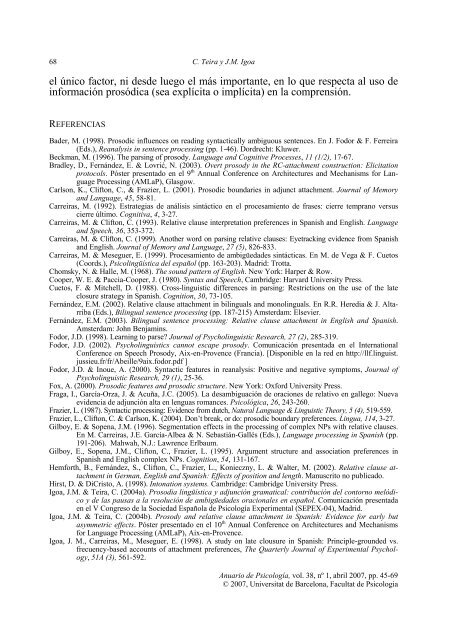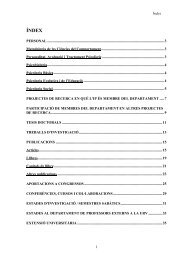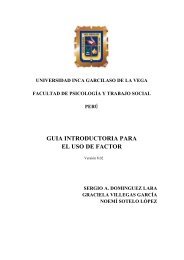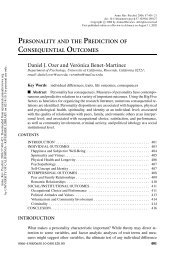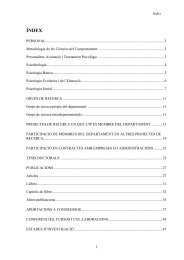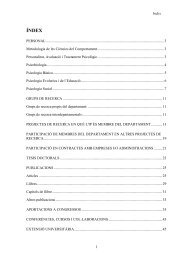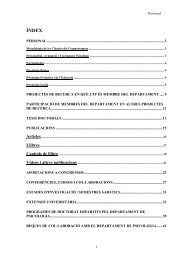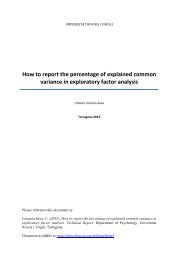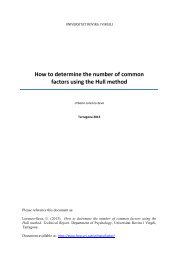Relaciones entre la prosodia y la sintaxis en el ... - RACO
Relaciones entre la prosodia y la sintaxis en el ... - RACO
Relaciones entre la prosodia y la sintaxis en el ... - RACO
Create successful ePaper yourself
Turn your PDF publications into a flip-book with our unique Google optimized e-Paper software.
68 C. Teira y J.M. Igoa<br />
<strong>el</strong> único factor, ni desde luego <strong>el</strong> más importante, <strong>en</strong> lo que respecta al uso de<br />
información prosódica (sea explícita o implícita) <strong>en</strong> <strong>la</strong> compr<strong>en</strong>sión.<br />
REFERENCIAS<br />
Bader, M. (1998). Prosodic influ<strong>en</strong>ces on reading syntactically ambiguous s<strong>en</strong>t<strong>en</strong>ces. En J. Fodor & F. Ferreira<br />
(Eds.), Reanalysis in s<strong>en</strong>t<strong>en</strong>ce processing (pp. 1-46). Dordrecht: Kluwer.<br />
Beckman, M. (1996). The parsing of prosody. Language and Cognitive Processes, 11 (1/2), 17-67.<br />
Bradley, D., Fernández, E. & Lovrić, N. (2003). Overt prosody in the RC-attachm<strong>en</strong>t construction: Elicitation<br />
protocols. Póster pres<strong>en</strong>tado <strong>en</strong> <strong>el</strong> 9 th Annual Confer<strong>en</strong>ce on Architectures and Mechanisms for Language<br />
Processing (AMLaP), G<strong>la</strong>sgow.<br />
Carlson, K., Clifton, C., & Frazier, L. (2001). Prosodic boundaries in adjunct attachm<strong>en</strong>t. Journal of Memory<br />
and Language, 45, 58-81.<br />
Carreiras, M. (1992). Estrategias de análisis sintáctico <strong>en</strong> <strong>el</strong> procesami<strong>en</strong>to de frases: cierre temprano versus<br />
cierre último. Cognitiva, 4, 3-27.<br />
Carreiras, M. & Clifton, C. (1993). Re<strong>la</strong>tive c<strong>la</strong>use interpretation prefer<strong>en</strong>ces in Spanish and English. Language<br />
and Speech, 36, 353-372.<br />
Carreiras, M. & Clifton, C. (1999). Another word on parsing re<strong>la</strong>tive c<strong>la</strong>uses: Eyetracking evid<strong>en</strong>ce from Spanish<br />
and English. Journal of Memory and Language, 27 (5), 826-833.<br />
Carreiras, M. & Meseguer, E. (1999). Procesami<strong>en</strong>to de ambigüedades sintácticas. En M. de Vega & F. Cuetos<br />
(Coords.), Psicolingüística d<strong>el</strong> español (pp. 163-203). Madrid: Trotta.<br />
Chomsky, N. & Halle, M. (1968). The sound pattern of English. New York: Harper & Row.<br />
Cooper, W. E. & Paccia-Cooper, J. (1980). Syntax and Speech, Cambridge: Harvard University Press.<br />
Cuetos, F. & Mitch<strong>el</strong>l, D. (1988). Cross-linguistic differ<strong>en</strong>ces in parsing: Restrictions on the use of the <strong>la</strong>te<br />
closure strategy in Spanish. Cognition, 30, 73-105.<br />
Fernández, E.M. (2002). Re<strong>la</strong>tive c<strong>la</strong>use attachm<strong>en</strong>t in bilinguals and monolinguals. En R.R. Heredia & J. Altarriba<br />
(Eds.), Bilingual s<strong>en</strong>t<strong>en</strong>ce processing (pp. 187-215) Amsterdam: Elsevier.<br />
Fernández, E.M. (2003). Bilingual s<strong>en</strong>t<strong>en</strong>ce processing: Re<strong>la</strong>tive c<strong>la</strong>use attachm<strong>en</strong>t in English and Spanish.<br />
Amsterdam: John B<strong>en</strong>jamins.<br />
Fodor, J.D. (1998). Learning to parse? Journal of Psycholinguistic Research, 27 (2), 285-319.<br />
Fodor, J.D. (2002). Psycholinguistics cannot escape prosody. Comunicación pres<strong>en</strong>tada <strong>en</strong> <strong>el</strong> International<br />
Confer<strong>en</strong>ce on Speech Prosody, Aix-<strong>en</strong>-Prov<strong>en</strong>ce (Francia). [Disponible <strong>en</strong> <strong>la</strong> red <strong>en</strong> http://llf.linguist.<br />
jussieu.fr/fr/Abeille/9aix.fodor.pdf ]<br />
Fodor, J.D. & Inoue, A. (2000). Syntactic features in reanalysis: Positive and negative symptoms, Journal of<br />
Psycholinguistic Research, 29 (1), 25-36.<br />
Fox, A. (2000). Prosodic features and prosodic structure. New York: Oxford University Press.<br />
Fraga, I., García-Orza, J. & Acuña, J.C. (2005). La desambiguación de oraciones de re<strong>la</strong>tivo <strong>en</strong> gallego: Nueva<br />
evid<strong>en</strong>cia de adjunción alta <strong>en</strong> l<strong>en</strong>guas romances. Psicológica, 26, 243-260.<br />
Frazier, L. (1987). Syntactic processing: Evid<strong>en</strong>ce from dutch, Natural Language & Linguistic Theory, 5 (4), 519-559.<br />
Frazier, L., Clifton, C. & Carlson, K. (2004). Don’t break, or do: prosodic boundary prefer<strong>en</strong>ces. Lingua, 114, 3-27.<br />
Gilboy, E. & Sop<strong>en</strong>a, J.M. (1996). Segm<strong>en</strong>tation effects in the processing of complex NPs with re<strong>la</strong>tive c<strong>la</strong>uses.<br />
En M. Carreiras, J.E. García-Albea & N. Sebastián-Gallés (Eds.), Language processing in Spanish (pp.<br />
191-206). Mahwah, N.J.: Lawr<strong>en</strong>ce Erlbaum.<br />
Gilboy, E., Sop<strong>en</strong>a, J.M., Clifton, C., Frazier, L. (1995). Argum<strong>en</strong>t structure and association prefer<strong>en</strong>ces in<br />
Spanish and English complex NPs. Cognition, 54, 131-167.<br />
Hemforth, B., Fernández, S., Clifton, C., Frazier, L., Konieczny, L. & Walter, M. (2002). Re<strong>la</strong>tive c<strong>la</strong>use attachm<strong>en</strong>t<br />
in German, English and Spanish: Effects of position and l<strong>en</strong>gth. Manuscrito no publicado.<br />
Hirst, D. & DiCristo, A. (1998). Intonation systems. Cambridge: Cambridge University Press.<br />
Igoa, J.M. & Teira, C. (2004a). Prosodia lingüística y adjunción gramatical: contribución d<strong>el</strong> contorno m<strong>el</strong>ódico<br />
y de <strong>la</strong>s pausas a <strong>la</strong> resolución de ambigüedades oracionales <strong>en</strong> español. Comunicación pres<strong>en</strong>tada<br />
<strong>en</strong> <strong>el</strong> V Congreso de <strong>la</strong> Sociedad Españo<strong>la</strong> de Psicología Experim<strong>en</strong>tal (SEPEX-04), Madrid.<br />
Igoa, J.M. & Teira, C. (2004b). Prosody and re<strong>la</strong>tive c<strong>la</strong>use attachm<strong>en</strong>t in Spanish: Evid<strong>en</strong>ce for early but<br />
asymmetric effects. Póster pres<strong>en</strong>tado <strong>en</strong> <strong>el</strong> 10 th Annual Confer<strong>en</strong>ce on Architectures and Mechanisms<br />
for Language Processing (AMLaP), Aix-<strong>en</strong>-Prov<strong>en</strong>ce.<br />
Igoa, J. M., Carreiras, M., Meseguer, E. (1998). A study on <strong>la</strong>te clousure in Spanish: Principle-grounded vs.<br />
frecu<strong>en</strong>cy-based accounts of attachm<strong>en</strong>t prefer<strong>en</strong>ces, The Quarterly Journal of Experim<strong>en</strong>tal Psychology,<br />
51A (3), 561-592.<br />
Anuario de Psicología, vol. 38, nº 1, abril 2007, pp. 45-69<br />
© 2007, Universitat de Barc<strong>el</strong>ona, Facultat de Psicologia


